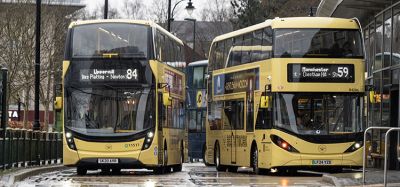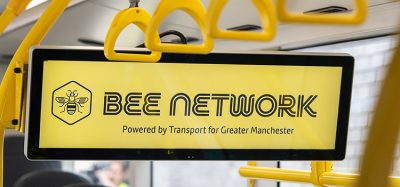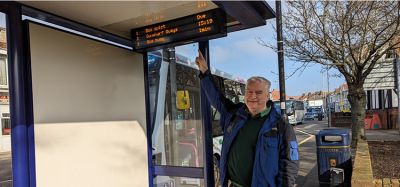Authorities upgrade passenger information
- Like
- Digg
- Del
- Tumblr
- VKontakte
- Buffer
- Love This
- Odnoklassniki
- Meneame
- Blogger
- Amazon
- Yahoo Mail
- Gmail
- AOL
- Newsvine
- HackerNews
- Evernote
- MySpace
- Mail.ru
- Viadeo
- Line
- Comments
- Yummly
- SMS
- Viber
- Telegram
- Subscribe
- Skype
- Facebook Messenger
- Kakao
- LiveJournal
- Yammer
- Edgar
- Fintel
- Mix
- Instapaper
- Copy Link
Posted: 24 June 2005 | James Abbott, Technical Editor | No comments yet
Public transport services can be confusing in busy cities. This is especially the case for occasional users who are unfamiliar with the system. These are the people that city authorities are seeking to draw out of their cars. An unhappy time using public transport – getting on the wrong bus, tram or train, or anxiety about doing so – is just the sort of experience that will send such people back to their cars.
For this reason many public transport authorities are spending large sums on upgrading their passenger information systems. Not only do passengers want to be reassured they are getting on the right vehicle when it arrives, they also want to be told how long they have to wait for the next service.
Public transport services can be confusing in busy cities. This is especially the case for occasional users who are unfamiliar with the system. These are the people that city authorities are seeking to draw out of their cars. An unhappy time using public transport – getting on the wrong bus, tram or train, or anxiety about doing so – is just the sort of experience that will send such people back to their cars. For this reason many public transport authorities are spending large sums on upgrading their passenger information systems. Not only do passengers want to be reassured they are getting on the right vehicle when it arrives, they also want to be told how long they have to wait for the next service.
Public transport services can be confusing in busy cities. This is especially the case for occasional users who are unfamiliar with the system. These are the people that city authorities are seeking to draw out of their cars. An unhappy time using public transport – getting on the wrong bus, tram or train, or anxiety about doing so – is just the sort of experience that will send such people back to their cars.
For this reason many public transport authorities are spending large sums on upgrading their passenger information systems. Not only do passengers want to be reassured they are getting on the right vehicle when it arrives, they also want to be told how long they have to wait for the next service.
While for trains, this information has long been available from the signalling system, it has only recently become available for buses. Consequently ‘countdown’ signs are appearing at bus stops which advise passengers of how long before their bus turns up.
Automatic vehicle location systems (AVLS) to drive these systems, run by Global Positioning Satellites or roadside beacons, are being used by increasing numbers of city transport authorities. An early example is in Rotterdam in The Netherlands, where Peek Traffic supplied a system that enabled controllers to hold back buses that were running early and threatening to catch up those in front of them. Working in this way smoothes out the service and overcomes the old complaint of a delay in arriving buses, followed by two or three coming at once.
French company SLE, a subsidiary of Mk IV of the USA, is an important supplier of AVLS for bus networks. SLE says that tracking and locating allows advances/delays to be calculated in real time for each vehicle, allowing controllers to take action to smooth out the service. The radio facility that comes with the system allows alarm messages to be broadcast, and the system can be used to generate statistics on operational data.
SLE has supplied its equipment to a number of cities in France. A typical example would be Bus Azur in Cannes on the Mediterranean coast, where AVLS is used to supply passenger information at bus stops and on vehicles. In Cannes, 52 buses have been equipped with on-board information display signs; there are 40 beacons and a central control room, which is linked to the buses on the road by radio. There are two radio bases, with automatic transfer of moving buses between the two radio bases.
Export orders won by SLE include Orvieto in Italy, Espoo in Finland and Neuchatel in Switzerland. The systems supplied for these towns are dwarfed by the ‘Countdown’ regulation and location system supplied to London. The Countdown system comprises 5,000 beacons and a central computer; it covers 1,500 signs and 60 remote work stations. This system was installed in the early 1990s, when the bus network in London was much smaller than it is today. The introduction of congestion charging in the centre of London two years ago was accompanied by a big increase in bus services, in order to increase public transport capacity to cater for people displaced from their cars. London’s bus fleet now numbers more than 8,000 vehicles.
In order to reflect this growth, Transport for London decided that an upgrade of the radio and information system was required. Following European Union procurement rules, Transport for London (TfL) went out to tender for the upgrade in a process that attracted 120 expressions of interest. The result was that a ten year supply-and-manage contract worth £120 million was let to Siemens in April 2005. The upgraded radio and information systems are due to be introduced on the London bus fleet in 2007. Siemens will provide a managed service, including operations management, support and maintenance services, installation and decommissioning of equipment, data centre hosting, fault management and training.
PPP upgrades
On the London Underground, passenger information on stations is being upgraded as part of the Public Private Partnership programme. The two PPP groups, Tube Lines and Metronet, both have passenger information modernisation programmes.
Tube Lines, which is responsible for upgrading the Jubilee, Northern and Piccadilly Lines, let a £150 million contract to the Marconi Corporation for the upgrade of the passenger information services across the JNP network. Marconi will be working with Amey Infrastructure Services, whose parent group is the majority shareholder in Tube Lines. The contract covers the station communications and SCADA (Supervisory Control and Data Acquisition) systems, as well as CCTV and security systems, public address, customer help points and visual information displays. Marconi will also provide Tube Lines with the software for a central management system, which will monitor other station assets such as lifts and ventilation systems. The contract consists of a six-year upgrade programme covering 74 stations and a maintenance contract supporting 100 stations over 13 years.
On the rest of the London Underground network, where Metronet is responsible for the infrastructure upgrade programme, the passenger information issue is being handled by Metronet shareholder, Atkins Rail. Atkins has recently let contracts worth more than £10 million for items such as electronic information display panels, public help points, public address systems, and platform/ticket office clocks to be installed on stations across the Bakerloo, Central and Victoria Lines and the Sub Surface Lines (Metropolitan, District, Circle, Hammersmith & City, and East London). The suppliers include Data Display and Varitext, responsible for display screens, and Application Solutions, which specialises in emergency public address for evacuation systems. Complus Teltronic and Commend International are the joint developers of distinctive help points – a blue button is provided for information requests, while a green button for emergency calls sets up an audio connection to the railway police control room, activating the video function so that the police can view the caller. Many help points are also equipped with a fire alarm button.
An £11 million contract has been let to Thales for the design and development of station management systems. The systems allow operators to monitor and control all of the station assets including passenger information displays, help points, lifts, escalators and public address and communications equipment across more than 150 stations.
For software, Thales is using the Wonderware Industrial Application Server. This is built on Invensys’ ArchestrA industrial automation and information software architecture.
Mind the gap
The ‘mind the gap’ announcements on the London Underground, advising passengers not to fall into the space between platform edge and the train, are famous all over the world. When the ‘mind the gap’ system at Finchley Road station developed a fault it was found to be obsolete. Interalia, a Canadian company that designs and manufactures digital voice announcement systems, was contracted to supply its Transit Voice system to Finchley Road as a replacement. This system is designed to deliver high quality audio messages to public address systems including ‘mind the gap’ and ‘stand clear of the doors’. Specially developed as an inexpensive passenger announcer for smaller low volume stations, Interalia says the Transit Voice replaces the original ‘mind the gap’ announcer at half the cost of the original system.
Up to four different audio messages may be triggered independently from one unit, with each message controlled by its own delay. In total, up to nine different messages can be stored, including emergency evacuation communications. The unit is easy to retrofit and can also be simply incorporated at stations where currently the train driver makes the ‘mind the gap’ announcements.
The Transit Voice units installed in the London Underground are triggered by track relays when the train enters the station, although other control transducers such as a manual trigger can also be used with the system. The system memory ensures messages are retained in the event of a power failure.
Following successful installation at Finchley Road, Transit Voice has been selected for Paddington and other stations. Transit Voice is one of two different platform announcers supplied to the London Underground by Interalia. The company has also supplied its more sophisticated Commander system to over 20 large Underground stations including Oxford Circus and Bank/Monument. In 2001, Interalia formed a joint venture project team to develop a Help Point System, which is now used extensively in London on both the Underground and at rail terminals.
Preparing for the World Cup
Next year, Germany will be hosting the World Cup soccer tournament. Extra capacity is hurriedly being built for the German public transport system, such as the Nuremberg-Ingolstadt high speed line and new lines in Berlin, in order to cater for the football crowds. Many of the World Cup spectators will be unfamiliar with the systems they are travelling on, so efficient passenger information is a must.
Berlin’s future Central Station (Lehrter station), which after its completion will be the largest interchange station in Europe, is to be equipped with customer information systems developed by Vossloh Information Technologies Karlsfeld GmbH (Vossloh IT). The order was placed by Balfour Beatty, the general contractor for the railway technical installations in three Berlin stations, Hauptbahnhof (Central Station), Potsdamer Platz and Papestraße.
At these stations, Vossloh IT Karlsfeld will install single and double-sided LCD (liquid crystal display) boards and also information display points and monitors. In the Central Station alone, customer information will be provided by more than 48 LCDs. Vossloh IT will carry out the entire data cabling for the Customer Information System (CIS) in all three stations and will also install the central CIS computer system in the Central Station.
In addition, every platform will be equipped with Vossloh IT’s sensor technology. This technology reliably determines when a train stops at a station platform and reports this to the operator of the Customer Information System. Besides regular schedule data, the CIS receives up-to-the-minute process data for the fully automatic control of the information displays at each station. This enables the system to identify deviations from scheduled operation such as delays or platform changes. The data is taken from the control system in the main operations control centre in Berlin and prepared for further processing in the CIS via a process data server which was developed by Vossloh IT and has already been in operation for some time. This advanced system was installed in the main station in Hannover by Vossloh IT prior to Expo 2000.
The Berlin order is worth €4 million and the project is due to be completed in January 2006.
Vossloh is familiar with the job of preparing city transit systems for large sporting events, as it helped upgrade information systems in Athens prior to the Olympic Games there last year.
Variety of screens available
While a systems integrator such as Vossloh will bring together the passenger information system and make it work, hardware for such systems is commonly bought in.
Display systems include LCD, light-emitting diode (LED), thin film technology (TFT) and cathode ray tubes (CRT – television screens). Each of these systems has its own advocates and some systems may be better suited to some locations than others.
For example, in its work for Athens, Vossloh installed 20 LCD platform displays, seven modern 40 inch TFT general view monitors and 16 LCD arrival and departure boards. The company says the LCD technology is ideally suited to local conditions as the displays have the necessary luminance to be easily read in the high light intensity of the sunny Greek environment.
In London, TFT technology is being used on the Underground. Irish company Data Display, one of the largest passenger information hardware suppliers, has developed a new 40 inch TFT display to offer passengers real-time information from the London Underground intranet. Data Display is now upgrading the passenger information systems across much of the Paris metro following an initial contract for Lines 13 and 4.
High-clarity TFT monitors from Postfield are being used by Tube Lines in London for displaying surveillance TV pictures.
In Germany, LED has been a popular choice in many cities. German company Lumino entered this market in 1987 with first Düsseldorf and then Berlin, Stuttgart and Essen. The company helped sign the Expo 2000 in Hannover and has worked in many other German cities since.








